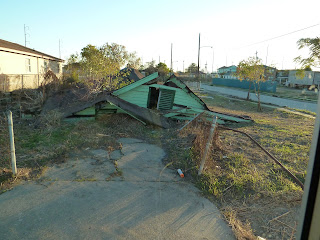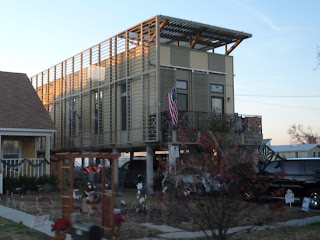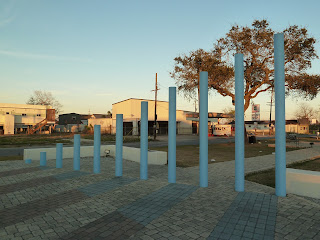A huge storm is headed your way, but you have no way to escape. What would you do? What would you then do if you survived the storm but where you live was totally destroyed? You have no way to get food, water, and other needed supplies. How would you feel about having to evacuate to a place where you had never been, a place where you know no one and had no prospects for finding a job? This is what many folks from New Orleans faced in the aftermath of Hurricane Katrina.
 | |||||||||||||||||||||||||||||||||||||||||||||||||||
| Category 5 Hurricane Katrina heads to New Orleans |
I can’t leave New Orleans without exploring the topic of Hurricane Katrina, a fierce storm that struck the Crescent City on August 29, 2005. Though five years have passed, New Orleans is still recovering. The area that was hardest hit was the Lower Ninth Ward, east of downtown.
The storm was not predicted to strike New Orleans until 19 hours before it landed there. That short amount of time made it impossible for 500,000 residents to evacuate because it requires 36 hours to evacuate the city. In addition, because New Orleans is a city where people walk and use public transportation, many people do not own vehicles so had no real way of escaping. Another important factor is that historically New Orleans has weathered many big hurricanes. One of the most devastating prior to Katrina was Hurricane Camille. A large number of people stayed thinking that they had survived Camille and there just was no way out of the city. Evacuating for many was impossible. It was a disaster in the making. To further complicate matters, the many levees and walls meant to protect New Orleans from flooding had not been well maintained.
Eighty percent of New Orleans is below sea level and it sits between the Mississippi River and Lake Pontchartrain making it prone to flooding. As odd as it seems, in New Orleans, the river is high ground. For more than one hundred years, efforts have been made to hold back the water in case of a flood. Levees built along the Mississippi River help protect the city from flooding if the river overflows. High walls also surround a series of canals used to move floodwater out of the city. Sadly, poor upkeep of the walls and levees meant that they were weak. When the powerful Category 5 hurricane struck, some of the weakened walls gave way, and water poured through the neighborhood. Within thirty minutes the water in the Lower Ninth Ward was ten feet high. Keep in mind that most houses have room ceilings that are eight feet tall. By the time the storm moved on, the water was seventeen feet high. Sixteen hundred people in New Orleans died as a result of Katrina, and most of them drowned. Prior to Katrina, the population of New Orleans was about 500,000. Today it is 360,000. So, where did 140,000 people go? Some moved away by choice, but many were displaced. They were sent to new locations around the United States, but were not told where they would end up. Imagine how frightened you might be if that happened to your family.
Before the storm there were three thousand houses in the Lower Ninth Ward. Today there are only 200 that are inhabitable, and that is after years of efforts to restore the area. After Hurricane Katrina moved on from New Orleans, it took the government two years to decide what to do about the devastation in the Lower Ninth Ward. If one of those houses had been yours, would you want to wait two years to find out if you could rebuild?
Insurance can help protect the loss of your home, but most policies do not include flooding. If your home is damaged by flood, you must have special flood insurance or your claim will be denied. The cost of flood insurance can be so high that many people cannot afford it. So, if your house is flattened—as many in the Ninth Ward were—and you do not have special flood insurance, you have to have enough money to rebuild your house. It is unlikely that anyone who cannot afford flood insurance would have a much, much larger sum to build a house from scratch.
I took many photos in the Lower Ninth Ward, and I will share some of them with you. Even though five years have passed, you can still see the devastation caused by Hurricane Katrina. Rebuilding is happening, but it is slow going. Heroic efforts by some famous individuals are helping the Ninth Ward recover. Brad Pitt, Oprah Winfrey, Harry Connick, Jr., David Letterman and organizations such as Habitat for Humanity and the Mennonite Disaster Service are spending time and money to assist families in the Lower Ninth Ward so that they can again have homes.
To help you understand the scope of the problem, below you will find many pictures of homes that have been boarded up. Remember, though, that there are many more than what you see in these pictures. Some probably could be repaired but the owners have no money or have been relocated to another state. Others are too damaged to be repaired. Bear in mind that this is one relatively small neighborhood. Think about your neighborhood. In many cases there are empty lots where houses once stood. What if this happened to you and your neighbors?
After the hurricane, every single house in the Lower Ninth Ward was checked for dead bodies. The zero at the bottom of the X means no one was found. You may have to enlarge the photo to see the markings left by the rescuers. Just click on it.
The next series of photos shows some of the rebuilding that is happening right now. The homes are all being painted in vivid colors to brighten the lives of the people and to give them hope that better days are coming. The new houses with solar panels are the ones being built by Brad Pitt. Other homes are being constructed by Habitat for Humanity. You will notice that many of the new homes have been built up off the ground, and some of the old ones that have been restored have also been built high up on concrete blocks. If another flood comes, these homes will be ready.
It is hard to see what's going on in this picture. Behind the large blue trash container is the FEMA trailer this family lived in until their house could be rebuilt. Notice how high off the ground the house has been raised.
This new construction is being supported by Brad Pitt.
Another house being built high off the ground
All of the new houses with solar panels like this one are being built by Brad Pitt.
The door at the bottom right contains an elevator so the owner can easily get to his house.
Finally, a monument has been erected in remembrance of this sad time. Part of it is a house under construction with chairs around it and one on the front porch to show that people again will sit on their front porches in the Lower Ninth Ward. The tallest blue pole shows how high the water of Katrina reached as it swept through the neighborhood. You can see how far above the lady’s head the water rose. Bad things do happen to people, but we must never give up hope that we can make things better.
This is part of the memorial to the Lower Ninth Ward victims of Hurricane Katrina.
The same memorial from a different angle
The tallest blue pole marks the height of the water when it flooded the Lower Ninth Ward.





































No comments:
Post a Comment